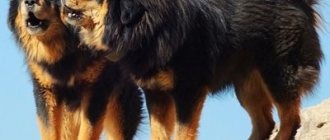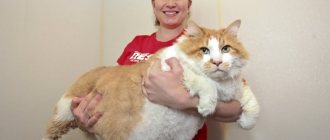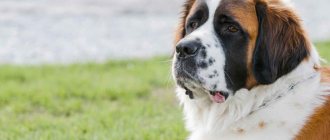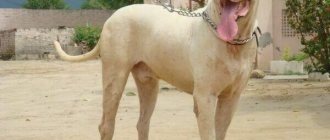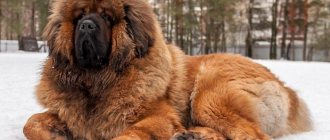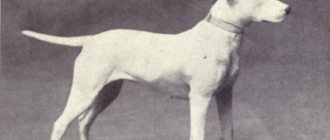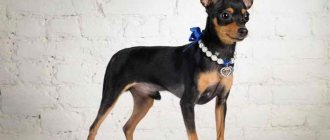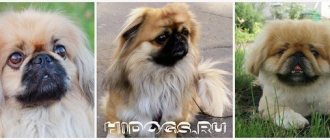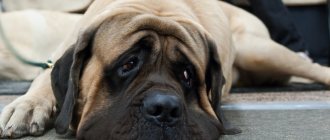Origin story
This breed is considered very ancient. In Tibetan and Himalayan monasteries, this breed of dog was originally used for protection. Merchants of the Middle Ages also often owned Tibetan mastiffs. They acted as guides and protectors of caravans, and, in addition, were excellent rescuers who helped pull people out of avalanches and warmed those who were freezing with their thick wool.
This breed is surrounded by various legends and myths. It is believed that even Aristotle praised the Tibetan mastiffs as the progenitors of all dogs belonging to the Molosser group.
The Tibetan Mastiff, as the largest dog, first appeared in Europe in 1847, it was brought as a gift to the Queen of England from the Indian king. Later, two more representatives of this breed were brought to England. The first offspring of these dogs even appeared in the Berlin Zoo in 1898.
According to information with varying degrees of reliability, the Tibetan mastiff was owned by Buddha, Alexander the Great, US President Eisenhower, Alain Delon and other famous personalities. (In the photo above, the Tibetan Mastiff is the largest dog.)
Myths and legends about the largest Tibetan mastiffs
The smallest shepherd in the world: description of the breed
Representatives of the breed are surrounded by a huge number of myths and legends. In ancient times, it was believed that the massifs were the descendants of predators: wolves, even jaguars. Science has proven that there is not a word of truth in this legend.
Man's best friend
Another popular myth is that mastiffs have a telepathic connection with their owner. It is difficult to judge telepathy, but these dogs really subtly sense the mood of their owner and try not to bother him.
The Romans and Greeks used dogs in the arena, and the animals became participants in gladiatorial fights. However, in fact, the mastiff's character is very good-natured. This is an affectionate and gentle giant dog who adores his owner.
When hunting, one mastiff can replace a whole row of 20 greyhounds, since it is distinguished by remarkable physical strength and endurance.
External description
The Tibetan Mastiff is the largest and most expensive breed known in the world. Its height at the withers can reach 71 cm, and the weight of individual individuals reaches 100 kg. He has a strong build and massive paws. The dog has thick hair on its head, reminiscent of a lion's mane. Moreover, his size and weight also give him a resemblance to the king of beasts.
The world's largest Tibetan mastiff, Hong Dong, was also the most expensive dog until 2012. It was bought by a Chinese millionaire for 1.5 million euros. However, he was replaced in second place by another representative of this breed - a male named Chief, who in 2012 was sold for 1.6 million euros.
History and interesting facts about the mastiff
Alabai Bulldozer: the largest Central Asian Shepherd in the world
The age of the breed is more than 5000 years. Over this long period, the animals remained virtually unchanged. Therefore, the first standard, adopted in 1122 BC. e. is still relevant today. A detailed description of the representatives of the breed was given by Aristotle, who believed that the formidable dog was a cross between a dog and a tiger. The philosopher noted the amazing size and special, deep, muffled bark. Marco Polo, who met a mastiff while traveling in China, was also impressed by the size of the animal.
The original purpose of the stern giant dogs was to protect the property of Tibetan temples. Gradually, the animals began to be considered elite; only wealthy people could have such a pet. Representatives of the breed not only had an impressive appearance, but also remarkable protective qualities, intelligence, and the ability to make decisions. However, the ferocity of the dogs is by no means a legend. Some mastiffs were indeed so formidable that their owners were forced to keep them locked up, letting them out for walks only at night.
Charming face
Tibet was closed to the rest of the world for a long time, which allowed the purity of the breed to be preserved. Animals were not able to interbreed with other breeds. Very rarely they left their homeland, for example, as a valuable gift to the ruler. The acquaintance with the Tibetans took place in the mid-19th century after a huge puppy was presented as a gift to the British Queen Victoria. They named him Siring.
Note! Mastiffs often worked in teams with Tibetan spaniels. The small dogs, sensing a stranger, began to bark loudly, calling for help from their huge partner.
Gradually we managed to get to know the breed better. In 1931, the Association of Tibetan Breeds appeared and standards were determined. However, the years of World War II almost caused the extinction of the breed. Mastiffs were saved, but they are still considered one of the rarest dogs in the world.
Characteristics
According to international standards, Tibetan Mastiffs, as the largest dogs, have the following characteristics:
- Tibet is considered the country of origin;
- males grow on average up to 66 cm, and females - up to 61 cm;
- the weight of males reaches 76 kg, and females - 59 kg;
- Puberty in a male occurs at 4 years, in a female - at 3 years;
- they live on average from 10 to 15 years;
- their body structure is strong;
- in proportions, the length of the mastiff’s body is greater than its height;
- Normally, the bite looks like a scissors, but a straight bite is also allowed;
- they have a red or black color, on which the presence of a white spot on the chest is allowed;
- they have long, straight, coarse hair with a thick undercoat;
- they belong to the group of pinschers, schnauzers and mastiffs;
- in terms of use, they are classified as guard and guard dogs, as well as companion dogs;
- they are recognized by all international cynological associations;
- they are also called Do-Khai, Tibetan Great Dane, Tibetan Molosser or Tibetan dog.
A record has been registered indicating how much the largest Tibetan mastiff weighed - 113 kg.
Currently, work is underway to reduce the body weight of this breed, since it leads to certain problems, namely, it affects the dog’s weak joints.
A photo of the world's largest Tibetan mastiff can be seen in the article.
Character and training of the dog
The mastiff, the largest representative of the dog breeds, has a stubborn and independent character. He has a hypertrophied sense of self-esteem and therefore requires increased attention to himself.
Socialization is very important for a dog of this breed. From an early age, puppies should be surrounded by people and other animals. You need to regularly walk him outside and introduce him to new people. It is important to take into account that mastiffs do not accept everyone.
This breed requires companionship, attention, and training. If such a pet begins to get bored, its independent entertainment, given its size, can be very destructive.
Even the largest Tibetan mastiff cannot live separately from people (a yard or an enclosure), since, being alone, it begins to acquire bad habits (digging, aggressive behavior, lack of obedience). In addition, the mastiff is not suitable for living in apartments, as he needs freedom of movement. Also, this breed is not recommended for families with children, since some children's games may be perceived by the mastiff as aggression towards him.
It is recommended to walk such a dog along different routes, since he perceives frequently visited places as his territory. For this reason, it may begin to establish its own rules on it.
A well-mannered dog that has everything it needs behaves quite calmly. However, if left alone for a long time, the mastiff may begin to bark loudly, alerting others to his presence. The bark of the Tibetan Mastiff (as the largest dog breed) is unique and is considered one of its valuable characteristics. In ancient times, Tibetan monks fed mastiffs with warm milk in order to preserve its thick and velvety timbre, comparable to the sound of a gong.
Features of maintenance and care
This breed is beyond the control of a novice dog breeder, so it is better to get a Tibetan Mastiff for a person who has previously had experience raising service breed dogs.
Choosing a puppy
Having decided to buy a Tibetan Mastiff, you should remember that how responsibly you approach the choice of a puppy will depend on what kind of pet you get. First you need to choose breeders who have a good reputation.
Before buying a puppy, you need to look at its parents, find out if everything is in order with their health and psyche, and whether they previously had healthy offspring. Having chosen the puppy you like, you should ask the breeders what order it was born in (stronger and more viable cubs are born first), how it behaves in the pack and how it differs from its brothers. The baby should be taken away from his mother at the age of 1-1.5 months, when he can already eat on his own. But you need to be prepared for the fact that even at this age the puppy is quite large and can weigh up to 9 kg. And they are born weighing 0.6-0.9 kg.
Raising a giant of this breed is a lot of work. As soon as the puppy has crossed the threshold of your home, you need to start raising it , otherwise you may end up with a problem dog in the future. The little mastiff needs to be taught to trust you. To do this, you need to constantly stroke the cub’s fur, talk to him affectionately and accept his invitation to play.
Be prepared for the fact that after playing too hard, this big guy can punch you more than once with his sharp puppy teeth. Like puppies of any other dog breeds, mastiffs are very active and indulge in small and large pranks. There is no need to shout at them for this, much less beat them, because you can easily lose the dog’s already well-deserved, but still shaky trust. And this may threaten that the dog will be afraid of you and mutual understanding with it will not be achieved.
As for nutrition, you need to feed the puppy often and in small portions. During the period of active growth, he needs foods rich in calcium, protein, vitamins and microelements. Or you can use a balanced food specifically designed for puppies. An adult dog needs two meals a day. For each of them, he should eat 0.3-0.4 kg of high-quality food . It is imperative to have access to clean water in sufficient quantities.
Another important point is that Tibetan mastiffs do not tolerate high temperatures well in the hot season and the best way out for them is to take shelter in the shade. Therefore, they should be given this opportunity.
What kind of care does the breed require?
If your big friend does not participate in exhibitions, then caring for him is not at all difficult and consists of combing his luxurious coat several times a week with a special comb.
If you are the owner of a show specimen, then you should prepare for the fact that the dog will need more frequent washing and subsequent blow-drying, the purpose of which is to lay the coat in the right direction.
Conditions of detention
The best place for a Tibetan Mastiff would be a house outside the city with a large adjacent territory, where he will feel like the master, since he needs a lot of space for walks and exercise. Thanks to its thick and warm coat, the mastiff feels great in frosty weather.
If he does live in an apartment, then it should be very spacious and the dog will need to be walked at least three times a day. However, in this case, the dog may lose the beauty and thickness of its fur coat.
Grooming
Even the largest size Tibetan Mastiff is not that difficult to care for.
This breed of dog sheds once a year or even less often, depending on the climate in which it lives. The Mastiff's coat should be brushed every week. Despite the fact that his “fur coat” rarely gets tangled, it is necessary to check it for tangles, because they cause pain to the dog.
During shedding, the fur is combed out as needed using special tools. It is recommended to carry out this procedure outdoors, since there will be a lot of hair.
Feed
In order for a dog to live long and without disease, it should be fed in a balanced manner. Tibetan Mastiffs are not prone to overeating, and their single portion of food does not exceed that of a Boxer or Labrador.
They sometimes go through a period of complete refusal to eat. However, veterinarians consider this to be the norm and does not cause any problems for the dog.
It is precisely because the mastiff eats little that the food must be balanced and of excellent quality.
You need to know that it is advisable to feed puppies with natural food, only when he grows up, begin a gradual transition to dry food. You should buy premium food that is designed specifically for this breed, as it will meet all the dog’s needs. There are the following rules to ensure good health of the mastiff:
- It is forbidden to feed your dog dry and natural food at the same time.
- You should not suddenly change food, as this may cause the mastiff to feel unwell.
- Feeding puppies with food for a different age category is also prohibited.
- The food must be at an acceptable temperature.
- It is prohibited to give your dog smoked food or river fish.
- Mastiffs that live outdoors need more protein in their diet.
Health and illness
People from snowy Tibet are distinguished by good health. Therefore, we can make you happy, since adult dogs of this breed practically do not get sick. However, even Tibetan mastiffs are characterized by certain diseases:
• decreased thyroid function or disease;
• dysplasia of the elbow and hip joints;
• hypertrophic neuropathy;
• inflammation of tubular bones;
• various ear diseases and infections;
• osteochondrosis.
Therefore, it is important to understand that you need to visit a veterinarian not only in cases when your furry friend falls ill, but also to prevent diseases. Also, do not forget about the importance of vaccinations. After all, a vaccinated dog is a healthy dog.
Choosing a puppy
Tibetan Mastiff puppies are born once a year. Therefore, their choice should be approached carefully. There are the following recommendations for choosing a mastiff puppy:
- First of all, you should study the photographs and pedigree of the parents.
- In the nursery, you need to pay attention to the conditions in which the dogs are kept, read the breeder’s documents and inquire about the character of the parents. In addition, you should make sure that the parents and puppies do not have hip dysplasia.
- When directly choosing a puppy, you should pay attention to the appearance, cleanliness of the ears and fur, the back (so that it is even) and the absence of a crease in the tail. The puppy should be shaggy, well-fed, heavy, with thick paws and a wide muzzle.
Price of a puppy in rubles: how much does a dog cost in Russia?
The average price of a grown-up show-class puppy in nurseries in Russia is from 90,000 to 160,000 rubles. The breed is rare and therefore expensive.
Adult Tibetan mastiffs from the pet category cost about 40-50 thousand rubles or a little more.
For example, the average cost of purebred “extra-class” puppies sold in China is about 25-35 thousand dollars, and sometimes higher. In the Middle Kingdom, the presence of a dog of this breed is an indicator of the high status and wealth of the owner.
Price
As mentioned above, the Tibetan Mastiff is the most expensive dog breed. Its price depends on the size, features, region of breeding and class. The cost of a healthy, purebred dog that meets international standards can reach 250 thousand dollars or more.
Tibetan Mastiffs have long held the position of the most expensive dogs, as they are one of the most ancient breeds in the whole world. Despite their long history, mastiffs have not lost their purebredness and valuable qualities.
The relatively low price of a puppy does not always mean the presence of some kind of flaw. A big role is played by the experience of the breeder, the number of awards the parents have and the desire to quickly sell the litter.
Nutrition
The Tibetan Mastiff is a large dog, so its daily diet should be high-carbohydrate and balanced. His body will actively transform carbohydrates into energy during the day, especially in the first half.
It is not recommended to feed your pet only certain foods, for example, only cereals or meat. He should regularly receive a full complement of nutrients, including fats, carbohydrates and proteins.
A Tibetan Mastiff puppy should eat a lot of raw meat to gradually gain weight and strengthen muscles and bones. He should also drink cow's milk for calcium supplementation. In addition, it is worth additionally feeding it with fruits and vegetables (vitamins and healthy minerals), as well as boiled cereals (amino acids).
Some useful tips for organizing your dog's nutrition:
- Don't give her too hot/cold water.
- Fill the bowl no more than halfway to prevent her from overeating.
- Exclude river fish from her menu.
- Giving sweets is strictly prohibited.

